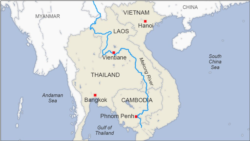Laos is getting a new round of aid and investment offers this year as foreign governments hope to dilute China’s increasing influence over the poor, landlocked country, observers in the region say.
Japan, Thailand and Vietnam have moved this year to offer new help or reaffirm the benefits of previous aid to Laos. Their assistance would arrive as a 400-kilometer, $5.9 billion China-invested railway is set for completion this year – the pinnacle of Chinese largesse for Laos.
Japanese Prime Minister Yoshihide Suga spoke this month with Lao counterpart Phankham Viphavanh to affirm plans for advancing a strategic partnership, Japanese media outlets say. Japan has offered about $1.8 million to open COVID-19 vaccine storage facilities and pledged support for upgrading international airports, the reports say.
In Thailand, Prime Minister Prayuth Chan-Ocha has spoken by phone to the new Lao leader, who took office in March, the official Lao News Agency reported this month. On those calls, Phankham thanked Thailand for providing scholarships in education, agriculture and health. Thailand has aided Laos further in fighting COVID-19, the news agency reported.
Vietnamese officials have launched a 2021-2030 cooperation strategy and a five-year cooperation agreement, the Communist Party of Vietnam’s news website, Nhan Dan, said. Leaders from both sides are due to decide later what the two deals will cover. Vietnam gave COVID-19 aid and 1,000 scholarships to Laos last year as well.
Chinese official flows of money into Laos have reached $11 billion per year, according to the Aiddata.org website operated by U.S. university William & Mary. Financing and investment would push the figure higher.
Other top donors are Japan and Thailand, with Vietnam emerging as a new one. Japan gave $63.8 billion in 2016, including grants, loans and technical aid, according to Japan’s Foreign Affairs Ministry.
Official development aid from all countries sometimes reaches 15% of Lao GDP. The economy has grown at an annual average of 5.8% during the past five years because of the “support of development partners and friendly countries,” the national news agency said. The support matters because about a quarter of the 7 million Laotians live in poverty.
Much of Asia hopes to lessen China’s influence so the superpower does not wield too much clout over the Mekong River, which flows from China through Myanmar, Laos, Thailand, Cambodia, and Vietnam, or over the region’s overland transport links, analysts say. Chinese dams control flows in the upper Mekong. The U.S. government raised its aid offer to Laos and its neighbors last year.
“Laos is kind of effectively being carved up in different directions but increasingly dominated by China,” said Thitinan Pongsudhirak, a political science professor at Chulalongkorn University in Bangkok. “What we’re seeing is [that] the major powers’ rivalry is dominating the region. Laos is just one pawn in this mix.”
Japan wants more “connectivity” in continental Southeast Asia, said Jeffrey Kingston, a history instructor at the Japan campus of Temple University. Chinese control of water flows into the Mekong further worries Japanese officials, he said.
“I just think that Japan is signaling that, [in] places that it looks like have been conceded to China’s influence, it is going to contest,” he said. “It is going to take an assertive posture toward these countries.”
Japan relies on Thailand for automotive production, while Japanese manufacturers are increasingly active in Vietnam – the result of investments made there since the 1980s. Land shipments can lower the cost of sending goods to more remote seaports.
Japan, alongside the United States. is pushing back against China, Thitinan said. Washington’s Mekong-U.S. Partnership, an aid plan launched in September, is seen as a counterweight to China in continental Southeast Asia, including Laos.
Japan spars separately with China over sovereignty in waters near its outlying islands, and leftover World War II issues.
Thailand typically finances Lao dams for hydropower and maintains close cultural ties with the bordering country, Thitinan said. Vietnam resents Beijing over its expansion in the disputed South China Sea and previous land border disputes, including a war in the 1970s.
“There’s that little battle for influence between Vietnam and China and Vietnam has been slowly losing influence to China,” said Jack Nguyen, a partner at the business advisory firm Mazars in Ho Chi Minh City.
China does not disclose aid and investment totals for Laos, but analysts say it depends more on China than on any other country. Now Laos, with a gross domestic product of less than $19 billion and an economy ravaged by COVID-19, is struggling to pay for the railway line.
Laos owed $250 million on railway last year, the International Monetary Fund has said.











